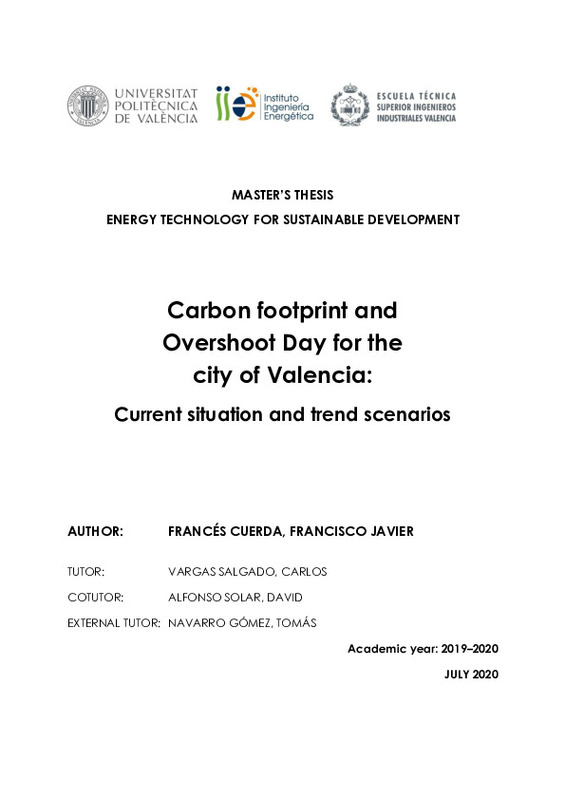|
Resumen:
|
[EN] This document consists on the development of the carbon budget and the calculation of the carbon
footprint for the city of Valencia. Firstly, the 'State of the Art' has been carried out to determine the
starting ...[+]
[EN] This document consists on the development of the carbon budget and the calculation of the carbon
footprint for the city of Valencia. Firstly, the 'State of the Art' has been carried out to determine the
starting point, taking into account that Valencia is a participating city in the Covenant of Mayors: a
global movement for climate and energy initiated in 2008, where its signatories seek, in their territories
at a local level, to accelerate decarbonization and access to safe, sustainable and affordable energy.
Therefore, there is already a previous work on the emissions inventory for the city (electricity
consumed by sectors, fuel consumption, etc.).
On this basis, the work is divided into two sections: the first one deals with the evaluation of existing
data and calculation methodologies, as well as the development and implementation of possible
proposals for their improvement. The second one, on the other hand, studies the possibility of
extending the scope of the emissions inventory by other aspects that have not been considered, in
order to obtain a more detailed view of the current situation.
Once the emissions inventory for the city has been obtained, the carbon footprint and the so-called
Overshoot Day or day of the year in which human activity consumes more resources than the
planet/region/city can generate in that year have been calculated. It should be noted that Overshoot
Day encompasses all types of land use (agriculture, fishing, forest land use, etc.). However, as this work
focuses on carbon, only the forest mass will be considered as a necessary resource to offset the carbon
footprint of the city.
Finally, a series of scenarios have been proposed for the year 2030 including new trendsfor sustainable
transition such as the decarbonization of private transport, change in consumption habits, etc., with
the aim of estimating the capacity of emission reductions in each area and how much their
implementation would cost.
[-]
[ES] El presente documento consiste en el desarrollo del inventario de emisiones y el cálculo de la huella
de carbono para la ciudad de Valencia. En primer lugar, se ha realizado el «Estado del Arte» para
determinar el ...[+]
[ES] El presente documento consiste en el desarrollo del inventario de emisiones y el cálculo de la huella
de carbono para la ciudad de Valencia. En primer lugar, se ha realizado el «Estado del Arte» para
determinar el punto de partida, teniendo en cuenta que Valencia es una ciudad participante en el
Pacto de los Alcaldes: un movimiento mundial para el clima y la energía iniciado en 2008, donde sus
firmantes buscan, en sus territorios a nivel local, acelerar la descarbonización y el acceso a una energía
segura, sostenible y asequible; por tanto, ya existe un trabajo previo sobre el inventario de emisiones
de la ciudad (electricidad consumida por sectores, consumo de combustible, etc.).
Sobre esta base, el trabajo se bifurca en dos líneas: la primera trata sobre la evaluación de los datos y
metodologías de cálculo ya existentes, así como la elaboración y aplicación de posibles propuestas de
mejora de los mismos. La segunda, por otro lado, estudia la posibilidad de ampliar el alcance del
inventario de emisiones mediante otros aspectos que no se hayan tenido en cuenta, a fin de obtener
una visión más detallada de la situación actual.
Una vez obtenido el inventario de emisiones para la ciudad, se ha calculado la huella de carbono y el
denominado Overshoot Day o día del año en el que la actividad humana consume más recursos de los
que el planeta/región/ciudad es capaz de generar en dicho año. Cabe puntualizar que el Overshoot
Day engloba todos los tipos de uso del terreno (agricultura, pesca, forestal, etc.), sin embargo, como
este trabajo se centra en el carbono, solamente se considerará la masa forestal como recurso necesario
para compensar la huella de carbono de la ciudad.
Finalmente, se han planteado una serie de escenarios para el año 2030 incluyendo nuevas tendencias
para la transición sostenible como pueden ser la descarbonización del transporte privado, cambio en
los hábitos de consumo, etc., con el objetivo de estimar la capacidad de reducción de emisiones de
cada ámbito y cuánto costaría su implementación.
[-]
|







